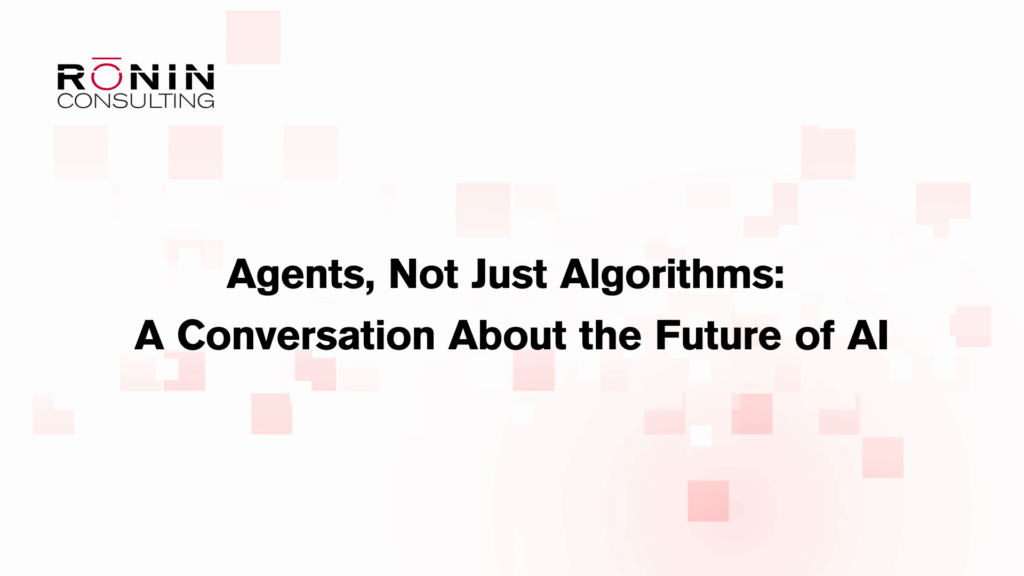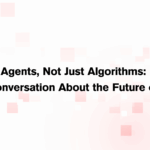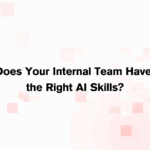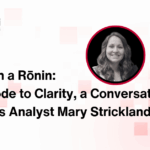
As AI takes center stage in many industries, few terms spark as much curiosity and confusion as “agentic AI.” What makes an AI agent different from a chatbot? Why does it matter for your business? And what does it look like in practice?
To unpack these questions, I sat down with Byron McClain, Co-Founder of Rōnin Consulting and one of the architects behind our AI initiatives. Our conversation explored what defines an actual AI agent, how companies can put agentic AI into practice, and why the future of AI represents more than just another wave of automation.
“An agent needs two main things: tools and memory.”
When I asked Byron what separates an AI chat from a true agent, he didn’t hesitate.
“The way I think about it,” he said, “is that an agent has basically two main components that make it an agent, versus just a chat with a large language model. The first thing is tools. An agent can interact with the environment around it.”
That “environment,” as Byron explained, might include a company’s SharePoint, email system, or CRM, anything an agent can connect to and use to execute a task. These integrations, often referred to as tools or plugins, give the agent a sense of reach and autonomy. Instead of simply answering a question (like a chatbot), an AI agent can act, pulling documents, sending reports, or flagging anomalies on its own.
“The other angle,” he continued, “is memory. There’s short-term and long-term memory. Short-term memory is the context of what’s happening right now, like the current time or what data it’s processing. Long-term memory is what allows you to come back ten days later and pick up the same conversation or process again.”
To put it simply, chatbots converse, while agents think, reason, and take action.
So…aren’t ChatGPT and Claude already agents?
For Byron, this question arises frequently, and there is considerable confusion surrounding these types of AI systems.
His answer? Yes—and no.
“In a lot of ways, they are agents,” he admitted. “ChatGPT and Claude fit the definition of an agent. They process input, take action, and have some form of memory. But the difference is control and compliance. When you build your own agent, you define exactly what data it can access, how it’s audited, and who can see the results.”
This distinction, between capability and control, is what separates consumer chatbots from enterprise-grade agentic AI. For organizations in regulated industries, such as healthcare and finance, it’s not enough for an AI system to function; it must also meet stringent governance and traceability requirements.
“If you don’t have constraints like observability or governance,” Byron said, “then Claude or ChatGPT is fine. But if you do, that’s when you need your own agentic system.”
Whatever a human can do, if they’re making a decision based on data, that’s a moment to review for automation.”
“Always review the action and the data.”
Once we clarified what makes up an agent, we turned to how they truly show up in business settings. Byron described how Rōnin is already applying agentic AI in real-world use cases, particularly in compliance automation and financial services.
“Take our work with a large financial company,” he said. “We built an agent that generates suspicious activity reports. The long-term memory is the set of guidelines it always follows. The short-term memory is the account data it’s working within that session. When the job’s done, that temporary memory goes away.”
That kind of ephemeral data handling, where the agent remembers only what’s necessary to complete the task, is not only efficient but also secure. And it highlights a key point about agentic AI: it’s not meant to replace humans, but to offload repetitive, rule-based decisions.
“We have clients asking us where they can implement an agent into their system, and I always say the same thing. Whatever a human can do, in any situation where they’re having to make decisions based on data, you need to stop and review that situation, because an agent could do it,” Byron said.
He’s quick to point out, though, that human oversight remains critical.
“We always push to have a human in the loop,” he added. “The idea is that you develop the system so the human is reviewing the agent’s work, approving it, or rejecting it. If it’s rejected, you feed that input back in and let the agent learn from it.”
This collaborative model, where AI acts as a capable teammate rather than an unchecked decision-maker, is an integral part of using AI smartly.
“It’s just a new form of custom software development.”
The conversation shifted toward implementation and the reality that while agentic AI feels like a new frontier, it’s really familiar territory for seasoned software architects.
“To me, this is all just a new type of custom development,” Byron said. “The more I do this, the more I realize it’s the same thing i’ve seen before…it’s just that one system is deterministic, one is nondeterministic.”
He compared today’s AI platforms to early SaaS tools: fast to deploy, but limited in scope.
“These off-the-shelf Agentic platforms out there today are like any SaaS product. You can use it, but you’re stuck in their box. Maybe you can customize the tools, but then you’re back into custom development again, only now it’s nondeterministic custom development.”
For small and midsize businesses using AI, Byron explained, those boxed solutions may be enough. But as an organization scales, so does the complexity of its data and workflows, and with it, the need for tailored AI infrastructure.
“And here we are again, where the same problems from early software development still apply,” he said. “Buy it off the shelf and you get up and running faster. But when your scale grows, you will hit walls, and that’s when you realize that you should build.”
“You can’t sit back this time. AI isn’t like the cloud.”
For Byron, one of the most urgent lessons for business leaders is that this AI wave moves differently.
“Unlike the cloud or smartphones, you could wait and catch up later,” he said. “With AI, you can’t just sit back and keep doing the same thing. What’ll happen is that some up-and-coming company will disrupt you, and there’s no way you can catch up. They’ll just smoke you.”
That sense of inevitability is what’s driving Rōnin’s “AI-first“ approach, where every engagement, whether it’s process automation or software modernization, now considers how Agentic systems can enhance it.
But even as many companies publicly claim to “use AI,“ Byron suspects much of it is surface-level.
There are a lot of companies beating their chests right now about AI, but if you look closely, most of what they’re doing is still just ChatGPT prompts. Building true agents—autonomous systems that make and act on decisions—that’s where we are, and that’s where the change comes.”
The future of AI is here
Agentic AI isn’t a trend, it’s a shift in how we build, interact with, and scale intelligent systems. As Byron put it, agents aren’t just tools; they’re partners capable of reasoning, adapting to context, and taking action within defined boundaries.
For organizations looking beyond chatbots, this is where the real work, and opportunity, begins. The next step isn’t simply adopting AI; it’s understanding how to extend it beyond conversation and into true collaboration.
To learn more about how you can implement agentic AI into your business, reach out to our team today.
Want More Content Like This?
Join the Rōnin Recap
Get expert insights on AI, integration, and the future of software — direct from the team at Rōnin Consulting. We’ll send you the good stuff, not spam.





